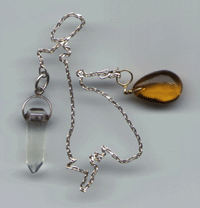
People have long been fascinated by pendulums.
 Their
rhythmic swaying has inspired both science and poetry throughout the ages.
Their
rhythmic swaying has inspired both science and poetry throughout the ages.
The earliest use of the pendulum in divination is lost in history. Yet, its simplicity makes it an ideal tool.
The pendulum, especially the chain, should be constructed of very lightweight materials. The one pictured uses a small crystal on the dangling or pointing end, and a small piece of amber by which the chain can be secured in the hand. The chain itself is extremely light and thin.
The simplest pendulum technique is directly related to the beginning exercise in developing internal communication. The swaying pendulum inscribes either a forward/backward or left/right arc or moves in a circle. These can be compared to Yes, No or Uncertain (or no answer right now, perhaps).
When using this technique, be certain to ask clearly Yes/No questions. Otherwise, you will be receiving many circular (uncertain) responses!
More complex techniques use a chart, which has letters inscribed in a circular pattern. As the pendulum sways, it points to various letters to spell out messages or give suggestions.
| Using
the Pendulum An important key to using the Pendulum is to use a light tether by which to suspend the proportionally heavier pointer. It can be made of string or thread, or of a very light chain. Whatever the material, it must be light enough to allow the pointer to swing freely with little or no impetus. Suspend the tether from your fingers and rest your elbow on a solid surface, such as a table. (Some suggest that the tether be held between the ring and middle finger to minimize one's own ‘subconscious' manipulation of the pendulum. Others don't believe it matters.) Ask first 'Which way is "Yes?" and observe as the Pendulum swings. Once you have received an answer, stop the Pendulum. Then ask, 'Which way is "No?" It is often useful to physically stop the Pendulum between questions, but you may find it unnecessary to do so with a little experience. |
By Gerry Starnes • All rights reserved.